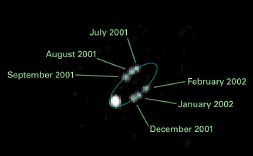

,
|
Документ взят из кэша поисковой машины. Адрес
оригинального документа
: http://www.stsci.edu/~inr/thisweek1/2008/thisweek315.html
Дата изменения: Tue Nov 11 01:41:58 2008 Дата индексирования: Wed Jan 14 14:22:50 2009 Кодировка: Поисковые слова: molecular cloud |


,
| Program Number | Principal Investigator | Program Title | Links |
| 11103 | Harald Ebeling, University of Hawaii | A Snapshot Survey of The Most Massive Clusters of Galaxies | Abstract |
| 11113 | Keith S. Noll, Space Telescope Science Institute | Binaries in the Kuiper Belt: Probes of Solar System Formation and Evolution | Abstract |
| 11212 | Filling the Period Gap for Massive Binaries | Douglas R. Gies, Georgia State University Research Foundation | Abstract |
| 11218 | Howard E. Bond, Space Telescope Science Institute | Snapshot Survey for Planetary Nebulae in Globular Clusters of the Local Group | Abstract |
| 11289 | Jean-Paul Kneib, Laboratoire d'Astronomie Spatiale | SL2S: The Strong Lensing Legacy Survey | Abstract |
| 11789 | George Fritz Benedict, University of Texas at Austin | An Astrometric Calibration of Population II Distance Indicators | Abstract |
| 11867 | John Trauger, Jet Propulsion Laboratory | HH 30 | Abstract |
| 11901 | Douglas R. Gies, Georgia State University Research Foundation | Filling the Period Gap for Massive Binaries | Abstract |
| 11942 | George Fritz Benedict, University of Texas at Austin | Increasing the Accuracy of HST Astrometry with FGS1r | Abstract |
GO 11113: Binaries in the Kuiper Belt: Probes of Solar System Formation and Evolution
 A composite of HST images of the Kuiper Belt binary, WW31
A composite of HST images of the Kuiper Belt binary, WW31
|
The Kuiper Belt consists of icy planetoids that orbit the Sun within a broad band stretching from Neptune's orbit (~30 AU) to distance sof ~50 AU from the Sun (see David Jewitt's Kuiper Belt page for details). Over 500 KBOs are currently known out of a population of perhaps 70,000 objects with diameters exceeding 100 km. Approximately 2% of the known KBOs are binary (including Pluto, one of the largest known KBOs, regardless of whether one considers it a planet or not). This is a surprisingly high fraction, given the difficulties involved in forming such systems and the relative ease with which they can be disrupted. It remains unclear whether these systems formed from single KBOs (through collisions or 3-body interactions) as the Kuiper Belt and the Solar System have evolved, or whether they represent the final tail of an initial (much larger) population of primordial binaries. This proposal will use WFPC2 imaging of known KBOs to identify new binary systems. |
GO 11289: SL2S - The Strong Lensing Legacy Survey
GO 11942: Increasing the Accuracy of HST Astrometry with FGS1r